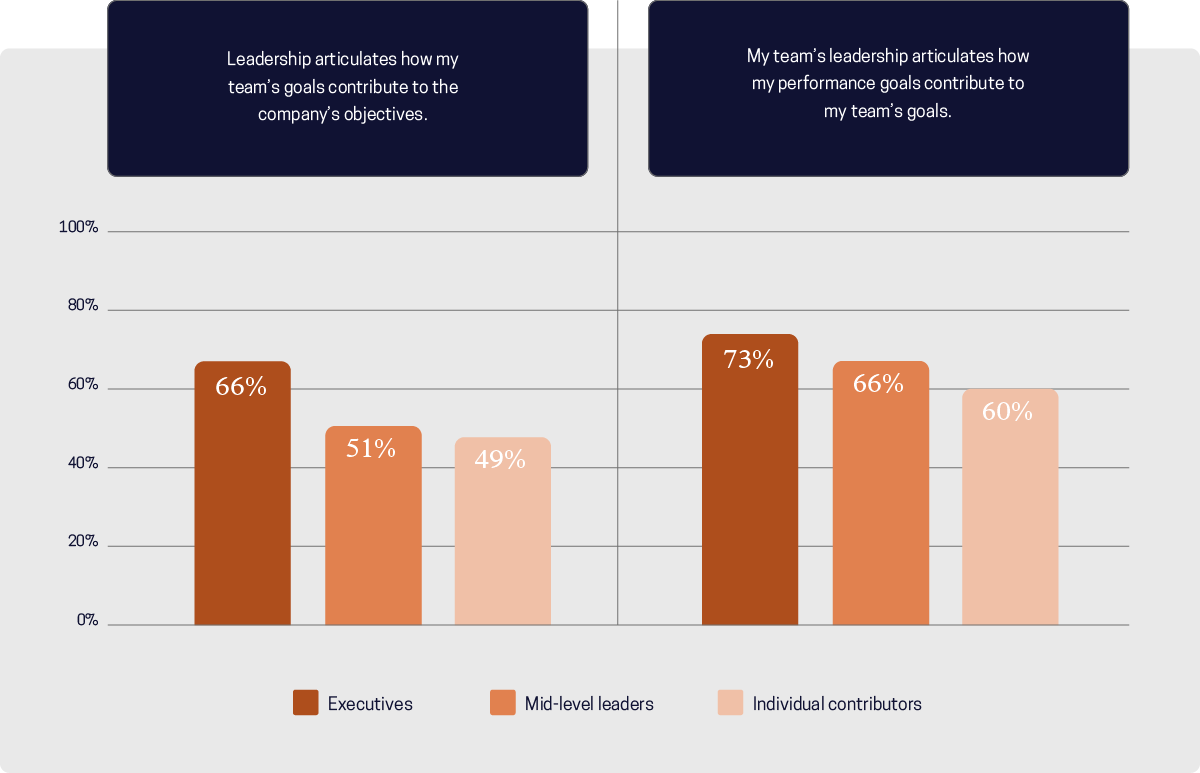Whether your teams struggle to align to broader company goals or your individual performance metrics fail to support collaborative team objectives, McChrystal Group leverages several tools to help organizations align objectives at all levels of the organization.
At McChrystal Group, we’ve collected data points on organizational operations from over 50,000 individuals across hundreds of teams from all industries and organizational levels. When examining financial data available from a small subset of our database, we found that the most important variable when it comes to future financial growth is whether teams are able to balance both long- and short-term priorities. Specifically, we found that companies whose employees reported difficulty balancing long- and short-term objectives had 1.6x lower median net income growth one year after data collection than companies in which all organizational levels reported better long- and short-term balance. What does this mean? When companies are able to operate with an eye to both long- and short-term priorities, they are more likely to experience financial growth.
Achieving this balance between long- and short-term priorities at all levels is a challenge that many organizations struggle to tackle. We have found that, on average, executive-level leadership score about 10% higher than do individual contributors on feeling that their teams balance these concerns successfully.
Finding the North Star to Prioritize Work
So, what pieces of the conversation are teammates missing when it comes to feeling capable of long- and short-term balance?
We have identified one likely contributing cause to this financially important breakdown. Our database of organizational trends suggests that in organizations where individual, team, and overall organizational goals are all clearly and explicitly linked to one another, employees at all levels report a higher degree of long- and short-term balance. In other words, when goals at the individual and team level are in support of clear organizational targets, employees all have a north star by which to prioritize work. This allows short-term work to feed directly into supporting long-term objectives, which in turn is related to achieving future revenue growth.
However, executive-level leadership is often overly confident about the extent to which they have sufficiently linked team goals to overall organizational objectives, and how individual performance goals are explicitly supportive of team goals. While executives often report very high levels of these elements of goal alignment, rarely do middle managers or individuals contributors share executives’ rosy perspective.
When working with one globally dispersed investment company, McChrystal Group found that individual contributors largely were not incentivized to work cohesively in support of overall company goals, but rather to work competitively to boost individual performance metrics. This led to an environment in which many mid-level experts focused on trading signals in isolation, without working with other research teams or portfolio managers. However, one specific mid-level leader was uniquely incentivized to support company-level goals, rather than just individual metrics. Using network analysis to identify key information conduits, McChrystal Group found that this mid-level leader’s assistance was so valuable to the rest of the company that nearly half of the organization went to him as an indispensable source of much-needed cross-functional information. The difference between this leader and others was not due to his specific expertise, but rather the fact that his individual performance goals made him willing to work collaboratively with other employees, rather than compete against them.
Goal Alignment Becomes Unclear at More Tactical Levels
The goal-alignment challenge faced by this investment company is not unique to one organization. We have found that not only do many companies struggle to align team and individual goals to broader company objectives, but also that goal alignment tends to further erode with each successive layer of the organization. In McChrystal Group’s work with other clients, we have found that, on average, executives score 16% higher than the rest of the organization when evaluating the extent to which team goals contribute to the company’s objectives, and 10% higher when assessing whether individual goals explicitly support team goals. When middle managers struggle to action their own team’s goals against the company strategy, and frontline contributors are solely focused on their personal objectives without a wider view toward the company mission, this is often damaging to a cohesive long-term execution orientation and ultimately to the bottom line.
Perceptions of Goal Alignment Are Eroded At Lower Organizational Levels

The question then becomes: how can leaders close the gap between the executives who set the objectives, and those charged with executing them? In the case of our investment company partners, senior leaders came together to develop a strategy that was cascaded throughout global offices, increasing transparency and teamwork in a previously siloed culture. To support this new strategy of teamwork, transparency, and sharing of information, McChrystal Group supported the implementation of a biweekly Keystone Forum attended by over 500 leaders across more than 20 offices worldwide. Employees capitalized on opportunities introduced by new communication and collaboration. With a newly aligned understanding of the vision, purpose, and objectives cascaded through all levels of the organization, the investment company’s trading profit exceeded its 3-year average by 8% in a year where the average investment organization returned only 6.10%.
Easy Ways to Improve
Whether your teams struggle to align to broader company goals or your individual performance metrics fail to support collaborative team objectives, McChrystal Group leverages several tools to help organizations align objectives at all levels of the organization. When employees are juggling competing priorities, we recommend establishing a process for bottom-up refinement to support and coordinate execution around shared priorities. This exercise, designed to feed information up to the leadership team with the feedback and insights they require to measure progress against initiatives, provides an indication of how conditions are changing within the organization, tracks opportunities, as well as highlights potential risks before misalignment can occur in practice.
To monitor progress on strategy implementation or adjust plans in the long-term, we also employ a six-quarter Rolling Operational Plan Review to serve as an evaluation method to assesses the performance of high priority initiatives and projects. By establishing a forum to ensure execution is on track to meet the objectives of a company’s multi-year strategy, leaders are better able to make course corrections in the near-term to get initiatives back on track for their teams. Integrating and aligning teams along a common narrative, reinforced through the six-quarter Rolling Operational Plan Review, allows mid-level managers and frontline staff to balance short- and long-term objectives, and consistently communicate the strategy to those executing it.
Appropriately prioritizing both long- and short-term objectives is an important precursor to companies’ future financial growth. In order for all levels of your organization to be able to balance these orientations successfully, all team members must have a clear understanding of how their individual goals contribute to team goals, and how team goals align to broader company strategies. Whether you are the leader of your organization, or a leader of teams within the organization, it is your responsibility to deliberately sustain both levels of goal alignment, so that your team will be better able to balance their short- and long-term requirements.



